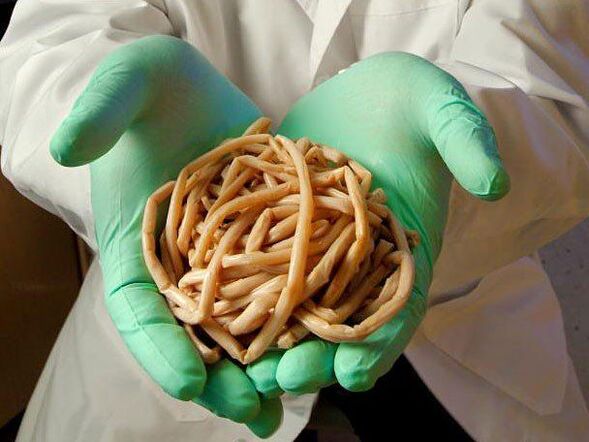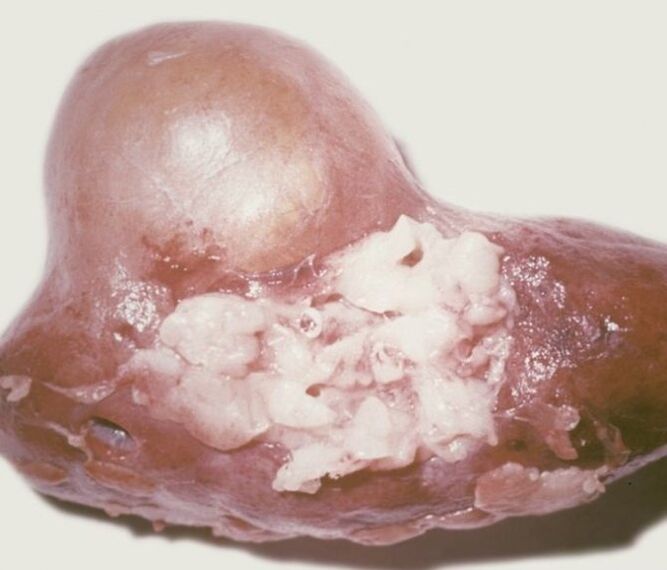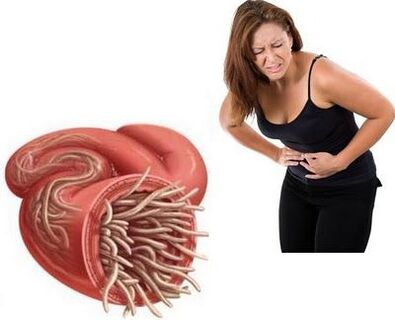Parasites - this is the name of one of the most common groups of infectious diseases.Today, about 300 parasites are known, which are a danger to humans, including a fatal.In the territory of the European continent, these are just a few dozen parasites (medical name - Helminthias, helminthic occupation).
Most of the important parasites for humans are common in countries with tropical and subtropical climate, as well as a low level of socio-economic development and sanitary culture.
What are the dangerous parasites

Parasites in the human body can affect almost any organ system.The rate of damage depends on the type of helminth, the duration of the disease, the initial state of health.The sooner the diagnosis of specific helminthic occupation is established, the more chances of saving the parasite quickly.That is why it is important to timely diagnose the state of occupation with the parasites and perform all stages of treatment.
Almost every variant of helminthiasis, especially for a long time, causes considerable harm to the human body.Hlybon occupation is the reason for the delay in developing psycho-motors in children of any age, significantly reduces performance and life reserves in an adult.
Regardless of a person's age, helminthic occupation contributes to allergies, reduces the ability of the immune system to resist infectious diseases and other, in addition, the effectiveness of the following vaccine prophylaxis is significantly reduced.
Cleaning the body of parasites in rare cases occurs spontaneously, in most cases, a specific treatment is needed for this according to a particular scheme.
What are the parasites

Parasites (they are also worms or worms) are a wide group of complex multicellular organisms that can exist for a long time in a different condition under different conditions.An important feature is the ability to exist within another living organism (person or animal), which is called "occupation".
Currently, different types of parasites in the human body are known.The most common classification of parasites depending on their external structure and life cycle features.
Given the biological features, all parasites are divided into 3 large classes:
- Round worms (they are also nematoda), for example, trichinella, ankylostoma, pin, ascaris;
- Ribbon worms (they are also cestode), for example, alveococcus, echinococcus, wide tape, clinical -clinical, pig and dwarf;
- Supers (they are also tremontoda), for example, opistorch, fasciol, clonorch.
In addition, like many other diseases, parasitic diseases vary:
- by severity;
- from the main syndrome, that is, which organ system is damaged to a greater extent;
- by the presence and nature of the complications;
- From the possible outcome of the disease.
The characteristics of the parasites
Stage of development
Parasitic diseases are characterized by a number of changes related to the features of the parasites and their life cycle.
The number of adults of parasites in the human body does not increase, provided there is no new infection.For the implementation of the life cycle, most parasites require a habitat change (animal body, soil, etc.).
For each parasite, the development stages are typical.Throughout the life cycle, Helminth passes a number of continuous stages of development.As a rule, the parasite egg is transformed into a larva and further into an adult individual.Reverse development does not occur, the egg cannot immediately go to the stage of an adult.
The parasite penetrates the human body at one stage of his life cycle and goes out to another.With this moment that is associated with non -treatment of practical persons of human parasitic diseases.That is, it is impossible to become infected with most parasitic diseases in direct contact with an infected person.
Possible paths of penetration into the human body
With many types of parasites, a person can meet anywhere - they are not visible to the free eye.The following options are most likely:
- The oral path, that is, with inconsistencies with personal hygiene, the use of dirty or thermally raw products;
- The percutaneous route, that is, the larvae or adults of the parasites penetrate the human body through skin damage when contacting water or soil, with the participation of blood singing insects.
Most of the parasites affecting the human body live in it only in the adult phase, mainly within the digestive tract.These are the so -called intestinal bowel parasites (helminths).They, in turn, are divided into 2 groups in accordance with several features.
The intestinal parasites of the first group enter the human body in the form of an egg.In the digestive tract, they turn into an adult individual.The movements of such parasites (pinworms, a wide ribbon, pig and bull cork) are limited only by various digestive tract departments.
Representatives of the second group (larvae or their eggs) perform significantly longer and complex migration according to various tissues and organs of the human body.Only after that is an adult individual of the formed parasite.It is clear that the symptoms of such parasitic diseases are much more diverse, as the migration process is associated with significant changes in the body.
The parasites, which at the stage of an adult or larvae are located outside the digestive tract are called tissue.If in the human body a parasite exists only in the larvae phase, then a person for him is a dead ecological end, which Helmint cannot remove.
Characteristics of the life cycle of parasites
To know how to get rid of parasites in the body, it is necessary to represent their life cycle in general terms.This knowledge also helps to prevent parasites from entering the human body.
In accordance with the features of the life cycle, all parasites are divided into:
- Geo parasites;
- Adhesive helminthoses;
- Bio Helminthiasis.
To apply the life cycle of geo parasites (Vlasov, a non -core), it is necessary for the eggs to be a certain period of time on Earth.In the future, with direct contact with filthy soil, the use of insufficiently washed vegetables, through dirty hands, the parasites penetrate the human body.
In contagiosteal parasites (pinte worms, dwarf tables), all stages of development occur only in the human body, without a change in the environment.Only these types of parasitic diseases are transmitted directly from person to person.Also also possible, especially in childhood, cases of new -auto generation, that is, by itself in the event of disregard for the rules and abilities of hygiene.
The most complex life cycle in so -called biogelmintosis.A prerequisite for the implementation of their life cycle is the presence of an intermediate host.A person can be either an intermediate or final master.For example, with echinococcosis, a person is an intermediate host, and dogs and cats are final.In the case of a tusherinchosis, on the contrary, the cattle representatives are intermediate hosts, and a person is final.
Symptoms of parasites
The clinical signs of parasites, on the one hand, are determined by the predominant damage of a particular organ, on the other hand, they have general characteristics that allow us to distinguish an acute and chronic phase of a parasitic disease.
The acute phase of a parasitic disease corresponds to the stage of migration of Helminths development.It is manifested by such clinical signs as allergic and general toxic reactions (ascariasis, skistosomosis, fasciolez, trichinellosis).
The immune component has a considerable weight in the development of the acute phase of parasitosis, forms a certain stereotype of the clinical figure and some similarities to other immune reactions of non -infectious nature - drugs, allergic dermatitis and others.
The hidden period with most of the parasitosis is several weeks, decreases to 7-10 days with a massive version of infection and lasts with poor intensity.
The main symptoms of parasitic diseases are as follows:
- Increased body temperature - from subfabrication to very high;
- pain in muscles and joints, duration and various intensity;
- The formation of a rash across the surface of the skin, in different size and intensity, accompanied by itching of the skin;
- Significant edema of the skin and subcutaneous tissue, less often - mucosa;The most typical for trichinellosis, which gave the disease a characteristic popular name "puffy";
- The development of pulmonary syndrome, that is, night coughing, asthmital conditions, pneumonia formation with a migratory focus of damage;
- The development of abdominal syndrome, which is characterized by moderate abdominal pain, liquid excrement without mucus and blood impurities;
- In severe cases, damage to the central nervous system and heart is observed;
- A distinctive feature of helminthiasis is changes in peripheral blood: pronounced leukocytosis and important eosinophilia (up to 30-40%).
In the treatment of the acute phase of the medication by parasites in the human body, the most effective.
In the chronic phase of the parasitic disease, the damaging effect is determined by the type of increased parasite.The negative effect on the human body is connected:
- larger toxic and less allergic effects;
- mechanical tissue damage in the parasitization area (for example, liver ecinococcosis);
- Nutrition absorption, a violation of metabolic processes, development of anemia and cachexia;
- heavy anemia;
- increased irritability and the harassment of a person;
- It is possible to join secondary infection and dysbiosis, the weight of the course of other infectious and non -infectious diseases, as well as pregnancy.
The duration of the existence of individual parasites is different - from a few days and weeks (cutters) to many years.After a parasitic disease, the re -infection is possible, as the immunity is not formed.Therefore, cleaning with a body time from the parasites does not protect against a repeated episode of the disease.
Treatment of parasites

Classic parasitosis drug therapy in the present has achieved considerable success.Introduction to the clinical practice of benzimidazole and imidazole compounds made it possible to treat many types of helminthias.
These medicines have a wide spectrum of exposure, small toxicity with a short course of treatment, for adults and children are suitable for use.The relevant age of the medication dose should be observed.
How to cleanse the body of a specific parasite, in which treatment regimen to choose and which medicine is decided by your doctor.It is not recommended to prevent helminthiasis in personal initiative, as it develops drug addiction, that is, a decrease in their effect.
Cleaning parasites
With parasitosis, treatment with folk remedies is no less popular than traditional medicine remedies.Proponents of natural remedies for parasitic diseases focus on the safety and universality of such therapy.There is a lot of traditional medicine recipe, which allows you to effectively cope with the parasites in the human body.The following options for eliminating parasites in the human body are the most famous:
- coriander and squash seeds as a prophylactic and therapeutic agent for parasites;
- Alcohol tincture in Chanterelleles combined with white mushrooms;
- a decoction of pine cones;
- Tincture of green nuts.
Anydo popular medicine for parasites should be done in accordance with the recipe and clean hands.Before choosing a special recipe, it is important to make sure a person does not have an allergy to the ingredients that are part of the medicine.
How to protect yourself from parasites

It is both easy and difficult at the same time.Some simple rules will help minimize the risk of infection with any parasite:
- thoroughly washing hands;
- the proper habit of using an individual set of dishes;
- Thoroughly process any meat and fish thermally, carefully use dried and salty people of fish and meat;
- treat vegetables and fruits with boiling water (after washing in running water);
- Always wash your hands with soap after communicating with animals (even homes).
Parasite infection at any age is an unpleasant problem, but complete elimination of early treatment.






































